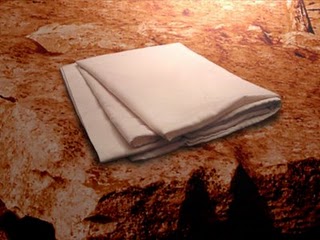 The detail of the folded napkin is found in the account of Jesus’ resurrection in John 20:7, “And the napkin, that was about his head, not lying with the linen clothes, but wrapped together in a place by itself” (KJV). Different respected translations of the Bible handle this verse differently. Three of them translate the verse with the word napkin (KJV, AS, RSV). Others translate it with “burial cloth” (NIV), “handkerchief” (NKJV), or “face-cloth” (NASB). The Greek word is saudarion, which comes from a Latin word for “sweat.” It can refer to a towel for wiping sweat from one’s face. It is used in the Greek to denote a towel or cloth, but not specifically a table napkin.
The detail of the folded napkin is found in the account of Jesus’ resurrection in John 20:7, “And the napkin, that was about his head, not lying with the linen clothes, but wrapped together in a place by itself” (KJV). Different respected translations of the Bible handle this verse differently. Three of them translate the verse with the word napkin (KJV, AS, RSV). Others translate it with “burial cloth” (NIV), “handkerchief” (NKJV), or “face-cloth” (NASB). The Greek word is saudarion, which comes from a Latin word for “sweat.” It can refer to a towel for wiping sweat from one’s face. It is used in the Greek to denote a towel or cloth, but not specifically a table napkin.
The other key word is folded. Was the burial cloth or napkin left folded in the tomb? Two of the translations use the word folded (NIV, NKJV). Others translate the word as “rolled up” (NASB, ASV, RSV) or “wrapped together” (KJV). The Greek word is entulisso, which is from words that may mean “to twist” or “to entwine.” The bottom line is that there is no agreement that it was a table napkin and no agreement that it was neatly folded in any meaningful way. The primary meaning of John 20:7 is that the cloth, which was placed over Jesus’ head or face at burial, was separate from the rest of His grave clothes. The significance of that, if there is any, is unknown.
 It has been rumored that folding the napkin at the table is a Jewish custom that means the person folding the napkin intends to return. Numerous Bible study sources have been checked, but there is nothing about this alleged Jewish custom of the folded napkins. The only references to this story seem to be from internet postings and emails that appear to have originated in 2007.
It has been rumored that folding the napkin at the table is a Jewish custom that means the person folding the napkin intends to return. Numerous Bible study sources have been checked, but there is nothing about this alleged Jewish custom of the folded napkins. The only references to this story seem to be from internet postings and emails that appear to have originated in 2007.
 Many Bible commentators and authors have used this creative illustration to make specific application to the resurrection and return of Jesus Christ. The truth is that table napkins, such as we use today, were not used in Jesus’ day. Jews would do an after-meal hand washing as part of the eating ritual. Washing of the hands before a meal was mandatory according to rabbinic injunction, but after washing their hands, did people dry them with a cloth? Apparently, there is no early rabbinic source that discusses how the hands were dried after washing them. The folding of the napkin as a sign that a dinner guest was finished may be good European custom, but it appears this custom was unknown in the land of Israel in the time of Jesus.
Many Bible commentators and authors have used this creative illustration to make specific application to the resurrection and return of Jesus Christ. The truth is that table napkins, such as we use today, were not used in Jesus’ day. Jews would do an after-meal hand washing as part of the eating ritual. Washing of the hands before a meal was mandatory according to rabbinic injunction, but after washing their hands, did people dry them with a cloth? Apparently, there is no early rabbinic source that discusses how the hands were dried after washing them. The folding of the napkin as a sign that a dinner guest was finished may be good European custom, but it appears this custom was unknown in the land of Israel in the time of Jesus.
.
.
culled from https://www.gotquestions.org/folded-napkin.html









